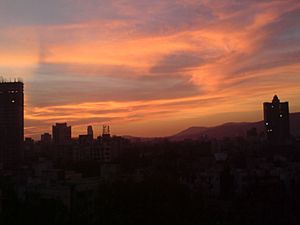Particulate facts for kids

Imagine tiny bits of stuff floating in the air around you. These super small pieces of solid or liquid are called particulates (say: par-TIK-yoo-lates). They are so small you often can't see them individually. But when there are many together, they can make the air look hazy or foggy.
When these tiny pieces are solid, like dust or soot, we often call it smoke. If the tiny pieces are liquid, like tiny water droplets or chemicals, it's known as an aerosol. Particulates are everywhere, from natural sources like volcanoes to human activities like driving cars.
Contents
What are Particulates?
Particulates are a mix of very small solid or liquid particles. They float in the air. Think of them like tiny specks of dust or invisible droplets. They are often called particulate matter or PM. Scientists measure them by their size.
Different Sizes of Particulates
Particulates come in many sizes. The most common ones you might hear about are PM10 and PM2.5.
- PM10 means particles that are 10 micrometers or smaller. A micrometer is super tiny, about one-hundredth the width of a human hair. These can include dust, pollen, and mold.
- PM2.5 means particles that are 2.5 micrometers or smaller. These are even tinier than PM10. They are about one-thirtieth the width of a human hair. These can come from burning things like wood or fuel. Because they are so small, they can stay in the air for a long time.
How Small Are They?
To give you an idea, a single human hair is about 50 to 70 micrometers wide. So, PM10 particles are at least five times smaller than a hair. PM2.5 particles are at least 20 times smaller! This tiny size allows them to float easily in the air.
Where Do Particulates Come From?
Particulates can come from many different places. Some sources are natural, while others are caused by human activities.
Natural Sources
Nature creates particulates all the time.
- Dust storms: Strong winds can pick up dirt and sand, creating huge clouds of dust.
- Volcanoes: Erupting volcanoes release ash and tiny rock particles into the air.
- Wildfires: Natural fires, often started by lightning, produce a lot of smoke and soot.
- Sea spray: When waves crash, tiny salt particles can become airborne.
- Pollen: Plants release pollen, which are tiny particles that float in the air.
Human-Made Sources
Many human activities also release particulates.
- Cars and trucks: Exhaust from vehicles contains tiny particles from burning fuel.
- Factories and power plants: Burning coal, oil, or gas to make electricity or products releases smoke and soot.
- Construction sites: Building and demolition work can kick up a lot of dust.
- Farming: Plowing fields can release dust into the air.
- Burning wood: Fireplaces and wood stoves produce smoke.
Why Are Particulates Important?
Particulates are important because they can affect our health, the environment, and even the climate.
Health Effects
Breathing in too many particulates can be bad for your health.
- Breathing problems: Tiny particles can get deep into your lungs. This can cause coughing, wheezing, and shortness of breath.
- Heart issues: Long-term exposure can worsen heart and lung diseases. It can even lead to heart attacks or strokes in adults.
- Asthma: Particulates can trigger asthma attacks in people who have asthma.
- Irritation: They can irritate your eyes, nose, and throat.
Environmental Effects
Particulates don't just affect people; they impact the environment too.
- Haze and reduced visibility: They can make the air look hazy. This reduces how far you can see, like in cities or national parks.
- Acid rain: Some particulates can mix with water in the air. This forms acid rain, which harms plants, lakes, and buildings.
- Damage to plants: Particulates can settle on leaves. This can block sunlight and make it harder for plants to grow.
Climate Effects
Particulates can also play a role in Earth's climate.
- Blocking sunlight: Some particulates, like soot, absorb sunlight. This can warm the air.
- Reflecting sunlight: Other particulates, like sulfates, reflect sunlight back into space. This can cool the Earth.
- Cloud formation: Tiny particles can act as seeds for clouds. This affects how clouds form and how much rain or snow falls.
How Are Particulates Measured?
Scientists and environmental agencies measure particulates to understand air quality. They use special equipment to collect air samples. Then they weigh the particles or count them. This helps them know how much particulate matter is in the air. This information helps create air quality alerts.
Images for kids
-
PM2.5 and PM10 compared with a human hair in a graphic from the Environmental Protection Agency
-
Global aerosol optical thickness. The aerosol scale (yellow to dark reddish-brown) indicates the relative amount of particles that absorb sunlight.
See also
 In Spanish: Partículas en suspensión para niños
In Spanish: Partículas en suspensión para niños








